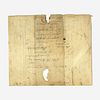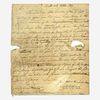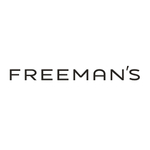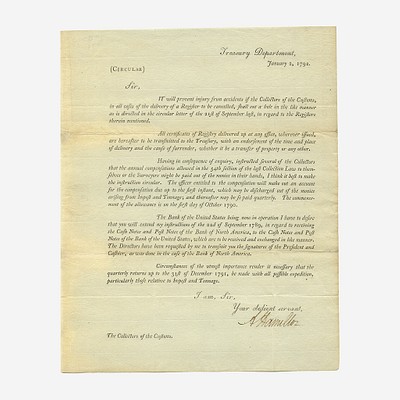[Hamilton, Alexander] [Lighthouses] Hamilton, Alexander Free-franked Address Leaf
About Seller
2400 Market St
Philadelphia, PA 19147
United States
Established in 1805, Freeman’s Auction House holds tradition close, with a progressive mind-set towards marketing and promotion, along with access to a team of top experts in the auction business. And now with offices in New England, the Southeast, and on the West Coast, it has never been easier to ...Read more
Two ways to bid:
- Leave a max absentee bid and the platform will bid on your behalf up to your maximum bid during the live auction.
- Bid live during the auction and your bids will be submitted real-time to the auctioneer.
Bid Increments
| Price | Bid Increment |
|---|---|
| $0 | $25 |
| $500 | $50 |
| $1,000 | $100 |
| $2,000 | $200 |
| $3,000 | $250 |
| $5,000 | $500 |
| $10,000 | $1,000 |
| $20,000 | $2,000 |
| $30,000 | $2,500 |
| $50,000 | $5,000 |
| $100,000 | $10,000 |
About Auction
Oct 25, 2021
Freeman's is honored to present The Alexander Hamilton Collection of John E. Herzog, a single-owner sale of Alexander Hamilton material, on October 25. Curated by Darren Winston, Head of the Books and Manuscripts Department. Freeman's info@freemansauction.com
- Lot Description
[Hamilton, Alexander] [Lighthouses] Hamilton, Alexander Free-franked Address Leaf
Alexander Hamilton's free-frank to Collector of the Customs for Baltimore
New York, September 28, 1789. One sheet, 9 1/8 x 7 3/4 in. (232 x 197mm). Alexander Hamilton's free-frank address leaf, to Collector of the Customs for Baltimore, Otho H. Williams, postmarked New York, September 28, 1789, with Williams's draft response to Hamilton, retained on verso, dated October 8, 1789. Addressed and docketed on free-franked side in Williams's hand: "22d September 1789/Alexr Hamilton/Balto 3d October 1789/Acknowledged Rect/& will observe contents"; the final word "Answered" appears to be in another unknown hand. Creasing from original folds, separations along same; toned and soiled; loss at center left and right edges from removed wax seal, affecting some words and letters of Williams's MS.; a few sello tape repairs recto. Lot includes a photograph of a lighthouse.
This draft was written on what was the third page of a once four-page document. The first two pages contained Hamilton's Treasury Department Circular, dated September 22, 1789. The third page was blank, and the fourth page was used to address it when folded and mailed. It appears that when drafting his letter, Williams confused the dates of the September 22 letter, per the docketing, and Hamilton's October 2 circular; despite Williams referencing the September 22 date in his letter, the entire content responds to Hamilton's October 2 circular. It is further corroborated by the franking date of September 28, and the date of the draft, October 8. William's recycled half of the original leaf as scrap paper to compose his draft. The completed letter can be found in The Papers of Alexander Hamilton, vol. 5, June 1788 – November 1789, ed. Harold C. Syrett. New York: Columbia University Press, 1962, pp. 431–432, showing the many emendations and corrections that Williams made to the letter.
As Ron Chernow observes about Hamilton's preoccupation with lighthouses, "This towering intellect scrawled more mundane letters about lighthouse construction than about any other single topic." Two months before Williams penned this letter Congress passed the Lighthouse Act, the first public works act under the new Constitution. The Act, among other things, transferred control of the existing 12 lighthouses in the United States from the individual states to the Federal Government. Williams starts by acknowledging receipt of Hamilton's September 22, 1789 Treasury Circular, but in fact, based on the content, is actually responding here to Hamilton's October 2, 1789 Treasury circular which asked the Collectors of the Customs to report on existing aids to navigation at the ports of their charge. As Williams writes to Hamilton, "that from Cape Henry to the extreme branches of the Susquehanna all inclusive there is not, that I have heard of, one single Light House, Buoy, Beacon or other Artificial object for navigators..." and hopes that "the subject will be taken into serious consideration at the ensuing (Congressional) Sessions..." In January 1790, Hamilton compiled the data received from the Collectors of the Customs, given in letters like the above, into a detailed report submitted to President Washington concerning the location of existing structures, annual expenses for maintenance, proposed superintendents, etc.The Cape Henry Lighthouse at Virginia Beach, Virginia, was built in response to Hamilton's report, and quite possibly spurred by this letter from Williams. The lighthouse was the first federally funded public works project of the new government, and Hamilton's first major infrastructure project as Secretary of the Treasury. It was completed in 1792.
- Shipping Info
-
No lot may be removed from Freeman’s premises until the buyer has paid in full the purchase price therefor including Buyer’s Premium or has satisfied such terms that Freeman’s, in its sole discretion, shall require. Subject to the foregoing, all Property shall be paid for and removed by the buyer at his/ her expense within ten (10) days of sale and, if not so removed, may be sold by Freeman’s, or sent by Freeman’s to a third-party storage facility, at the sole risk and charge of the buyer(s), and Freeman’s may prohibit the buyer from participating, directly or indirectly, as a bidder or buyer in any future sale or sales. In addition to other remedies available to Freeman’s by law, Freeman’s reserves the right to impose a late charge of 1.5% per month of the total purchase price on any balance remaining ten (10) days after the day of sale. If Property is not removed by the buyer within ten (10) days, a handling charge of 2% of the total purchase price per month from the tenth day after the sale until removal by the buyer shall be payable to Freeman’s by the buyer. Freeman’s will not be responsible for any loss, damage, theft, or otherwise responsible for any goods left in Freeman’s possession after ten (10) days. If the foregoing conditions or any applicable provisions of law are not complied with, in addition to other remedies available to Freeman’s and the Consignor (including without limitation the right to hold the buyer(s) liable for the bid price) Freeman’s, at its option, may either cancel the sale, retaining as liquidated damages all payments made by the buyer(s), or resell the property. In such event, the buyer(s) shall remain liable for any deficiency in the original purchase price and will also be responsible for all costs, including warehousing, the expense of the ultimate sale, and Freeman’s commission at its regular rates together with all related and incidental charges, including legal fees. Payment is a precondition to removal. Payment shall be by cash, certified check or similar bank draft, or any other method approved by Freeman’s. Checks will not be deemed to constitute payment until cleared. Any exceptions must be made upon Freeman’s written approval of credit prior to sale. In addition, a defaulting buyer will be deemed to have granted and assigned to Freeman’s, a continuing security interest of first priority in any property or money of, or owing to such buyer in Freeman’ possession, and Freeman’s may retain and apply such property or money as collateral security for the obligations due to Freeman’s. Freeman’s shall have all of the rights accorded a secured party under the Pennsylvania Uniform Commercial Code.
-
- Buyer's Premium



 EUR
EUR CAD
CAD AUD
AUD GBP
GBP MXN
MXN HKD
HKD CNY
CNY MYR
MYR SEK
SEK SGD
SGD CHF
CHF THB
THB![[Hamilton, Alexander] [Lighthouses] Hamilton, Alexander Free-franked Address Leaf](https://s1.img.bidsquare.com/item/l/9470/9470921.jpeg?t=1MwoEQ)
![[Hamilton, Alexander] [Lighthouses] Hamilton, Alexander Free-franked Address Leaf](https://s1.img.bidsquare.com/item/s/9470/9470921.jpeg?t=1MwoEQ)





![[CIVIL WAR] M1858 Canteen](https://s1.img.bidsquare.com/item/m/2904/29040149.jpeg?t=1TtmmQ)
![[CIVIL WAR] M1860 (1859) Cavalry Saber by Ames](https://s1.img.bidsquare.com/item/m/2903/29033794.jpeg?t=1TsJBt)
![[CIVIL WAR] Signal Corps Turpentine Canteen](https://s1.img.bidsquare.com/item/m/2911/29117909.jpeg?t=1TvAP1)
![[CIVIL WAR] 1863 Bombardment of Ft. Sumter, Letter from Inside](https://s1.img.bidsquare.com/item/m/2983/29830429.jpeg?t=1TO4kT)
![[CIVIL WAR] Captured at Gettysburg w/ Battle Content](https://s1.img.bidsquare.com/item/m/2982/29826250.jpeg?t=1TO1hq)
![[CIVIL WAR] Confederate Soldier's Estate, KIA Gettysburg](https://s1.img.bidsquare.com/item/m/2979/29795962.jpeg?t=1TNm38)
![[CIVIL WAR] D.J. Millard US C.E.W. 1862 Sword](https://s1.img.bidsquare.com/item/m/2957/29577356.jpeg?t=1THyqW)
